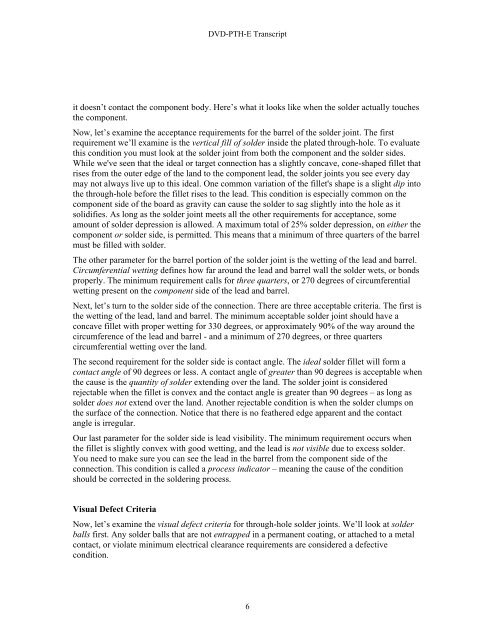DVD-PTH-E Through-Hole Solder Joint Workmanship Standards
DVD-PTH-E Through-Hole Solder Joint Workmanship Standards
DVD-PTH-E Through-Hole Solder Joint Workmanship Standards
- No tags were found...
Create successful ePaper yourself
Turn your PDF publications into a flip-book with our unique Google optimized e-Paper software.
<strong>DVD</strong>-<strong>PTH</strong>-E Transcriptit doesn’t contact the component body. Here’s what it looks like when the solder actually touchesthe component.Now, let’s examine the acceptance requirements for the barrel of the solder joint. The firstrequirement we’ll examine is the vertical fill of solder inside the plated through-hole. To evaluatethis condition you must look at the solder joint from both the component and the solder sides.While we've seen that the ideal or target connection has a slightly concave, cone-shaped fillet thatrises from the outer edge of the land to the component lead, the solder joints you see every daymay not always live up to this ideal. One common variation of the fillet's shape is a slight dip intothe through-hole before the fillet rises to the lead. This condition is especially common on thecomponent side of the board as gravity can cause the solder to sag slightly into the hole as itsolidifies. As long as the solder joint meets all the other requirements for acceptance, someamount of solder depression is allowed. A maximum total of 25% solder depression, on either thecomponent or solder side, is permitted. This means that a minimum of three quarters of the barrelmust be filled with solder.The other parameter for the barrel portion of the solder joint is the wetting of the lead and barrel.Circumferential wetting defines how far around the lead and barrel wall the solder wets, or bondsproperly. The minimum requirement calls for three quarters, or 270 degrees of circumferentialwetting present on the component side of the lead and barrel.Next, let’s turn to the solder side of the connection. There are three acceptable criteria. The first isthe wetting of the lead, land and barrel. The minimum acceptable solder joint should have aconcave fillet with proper wetting for 330 degrees, or approximately 90% of the way around thecircumference of the lead and barrel - and a minimum of 270 degrees, or three quarterscircumferential wetting over the land.The second requirement for the solder side is contact angle. The ideal solder fillet will form acontact angle of 90 degrees or less. A contact angle of greater than 90 degrees is acceptable whenthe cause is the quantity of solder extending over the land. The solder joint is consideredrejectable when the fillet is convex and the contact angle is greater than 90 degrees – as long assolder does not extend over the land. Another rejectable condition is when the solder clumps onthe surface of the connection. Notice that there is no feathered edge apparent and the contactangle is irregular.Our last parameter for the solder side is lead visibility. The minimum requirement occurs whenthe fillet is slightly convex with good wetting, and the lead is not visible due to excess solder.You need to make sure you can see the lead in the barrel from the component side of theconnection. This condition is called a process indicator – meaning the cause of the conditionshould be corrected in the soldering process.Visual Defect CriteriaNow, let’s examine the visual defect criteria for through-hole solder joints. We’ll look at solderballs first. Any solder balls that are not entrapped in a permanent coating, or attached to a metalcontact, or violate minimum electrical clearance requirements are considered a defectivecondition.6

















